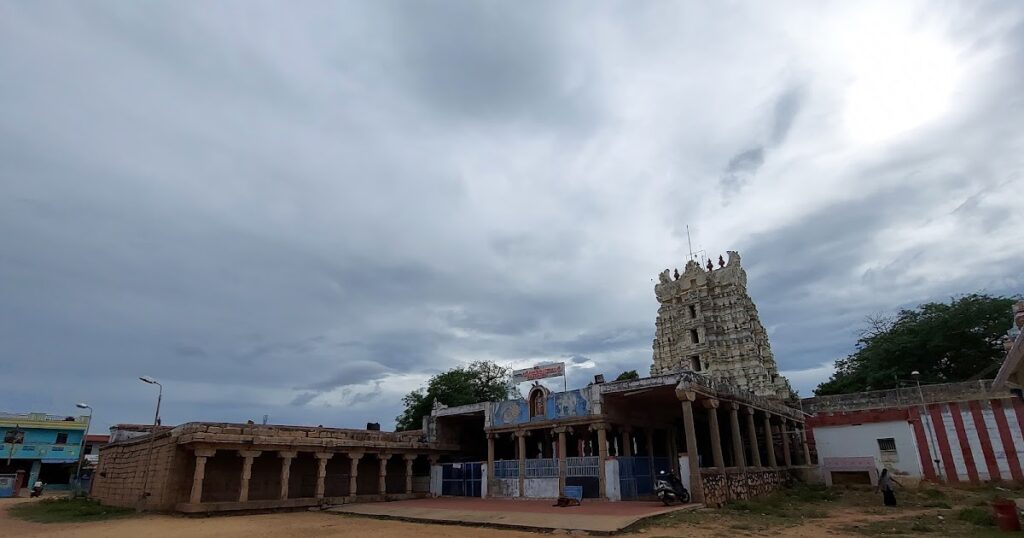About 13 kilometers from Tirunelveli lies the historically resonant village of Krishnapuram, home to the awe-inspiring Venkatachalapati Temple. For those unable to journey to Tirupati, this 16th-century shrine offers a sacred alternative. But beyond spiritual fulfilment, Krishnapuram offers a breathtaking artistic experience—a sculptural gallery carved in stone, unmatched in narrative and finesse.
Unlike typical temple narratives that begin with the presiding deity or architectural layout, Krishnapuram demands a different approach. Here, it is the sculptural brilliance of the Nayaka period that commands attention. With photography strictly prohibited inside, every visit becomes a fresh discovery.
This is the ninth article in my series. In the first six, I covered the sculpted pillars of the Veerappa Nayakka Mandapa. The seventh and eighth episodes focused on the easternmost pillars of the Mukha Mandapa, facing north. In this episode, we explore the fifth, sixth, and seventh pillars in succession, revealing layers of artistic complexity.
.jpg) |
| Krishnapuram Temple |
Fifth Pillar: Trunked Yazhi and Scenes of Life and Devotion
The fifth pillar features a stunning Gaja Yazhi, its trunk wraps around a smaller elephant below, showcasing a creative sculptural concept with mythic overtones.
East Face:
-
A dancing girl in a poised stance.
-
A woman resting her hand on her head, possibly in an expressive Natya pose.
-
A lion, symbol of strength and guardianship.
-
A girl playing the veena, seated with one leg hanging—a lifelike and serene representation of musical devotion.
South Face:
-
A bearded Veerabhadra, in the signature Nayaka warrior style, exuding fierce energy.
-
A robust figure of Hanuman, the epitome of strength and devotion.
West Face:
-
A soldier holding a bow, alert and battle-ready.
-
Dancing Krishna, full of rhythm and grace.
-
Narasimha, in a dynamic stance.
-
Bhima holding his mace, a preview of what is to come on the sixth pillar.
Sixth Pillar: Bhima and the Towering Purushamriga
This sixth pillar commands attention with its life-size sculpture of Bhima, the Pandava known for his colossal strength.
Bhima stands in a heroic pratyalidha posture, his massive gada (mace) raised diagonally over his shoulder. His prominent moustache, deeply etched chest ornaments, and tight udarabandha (waist girdle) give him a fierce, martial appearance. The intricacy of his keyura (armlets) and kanthis (neck ornaments) adds to his majesty.
(Sidenote: “Pratyalidha” is a dynamic standing posture where one leg is placed forward and the other is stretched back—commonly used in Indian iconography to depict warriors or deities in battle-ready stance.)
Behind Bhima, in almost equal scale, stands the Purushamriga—a rare, part-human, part-beast guardian figure from South Indian temple tradition.
With the body of a lion and the face of a human, the Purushamriga is believed to protect the temple and uphold righteousness. Its wide eyes and sharp teeth contrast with a calm expression, as if watching over everything with quiet power.
East Face:
-
A small Purushamriga on the capital.
-
Below it, an eight-armed Narasimha tearing open the stomach of the Asura Hiranyakashipu—one of the most potent depictions of divine fury.
West Face:
-
A life-size soldier, with a thick moustache and vibhuti marks. (Sidenote: Vibhuti is the sacred ash worn as white lines on the body, especially by Shiva devotees, symbolizing purity and detachment.)
-
His left arm rests on his hip, while the right hand is raised in a warning gesture (Tarjani mudra).
-
The capital features a lion.
-
Two dancing girls, elegantly positioned.
-
A bearded figure with visible breasts, possibly a symbolic or composite character—adding a touch of gender fluidity.
Seventh Pillar: Simha Yazhi and a World in Miniature
The seventh pillar continues the parade of masterful design, anchored by a massive Simha Yazhi. A curious scene unfolds below: a monkey eating something, carved with attention to detail that evokes humor and everyday life.
East Face:
South Face:
West Face:
-
A dancing girl.
-
Krishna battling a bird-asura—a dramatic mythic scene full of kinetic motion.
-
An illusion sculpture of an elephant and a Nandi sharing the same head, a clever play on perspective.
-
A Deva figure carved on the capital, adding a celestial presence.
With each pillar of the Mukha Mandapa, the sculptors of Krishnapuram push artistic boundaries. The dynamism of Bhima, the mystique of Purushamriga, the narrative layers of Hanuman, Krishna, Narasimha, and Kali—all speak of a sculptural tradition that blends devotion, symbolism, and unmatched craftsmanship.
In the next episode, we will continue our exploration of the remaining pillars and delve deeper into the storytelling encoded in stone.
Happy travelling.
This is Part 9 of the series of articles on Krishnapuram Temple. If you are interested to read the earlier parts of the series, click the links below.
Part 1
Part 2
Part 3
Part 4
Part 5
Part 6
Part 7
Part 8

